Comprehensive Analysis: Protection of Children and Vulnerable Persons
VerifiedAdded on 2020/05/16
|12
|2959
|492
Report
AI Summary
This report delves into the critical issues surrounding child protection practices in Ireland. It explores the complexities of reporting procedures for child abuse, highlighting the roles of Tusla and relevant legislation. The report also examines the challenges faced by interagency collaboration, particularly in risk assessment processes, and identifies barriers to effective teamwork between social workers, healthcare professionals, and other agencies. It discusses the impact of professional biases, inadequate training, and the importance of family support in child welfare. The report emphasizes the need for improved information sharing, enhanced collaboration, and a more holistic approach that considers both the needs of children and their families to ensure effective child protection and reduce the risks of harm.
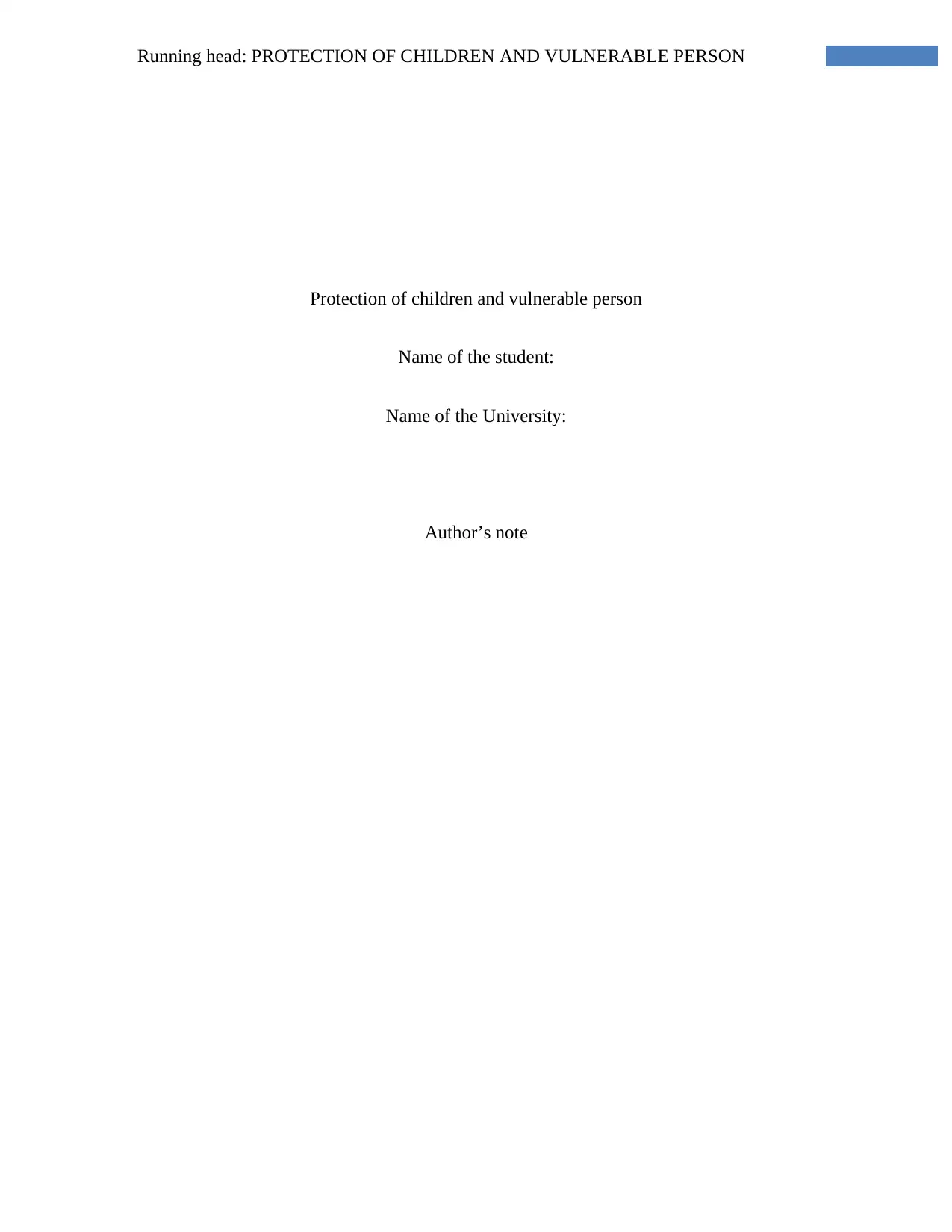
Running head: PROTECTION OF CHILDREN AND VULNERABLE PERSON
Protection of children and vulnerable person
Name of the student:
Name of the University:
Author’s note
Protection of children and vulnerable person
Name of the student:
Name of the University:
Author’s note
Paraphrase This Document
Need a fresh take? Get an instant paraphrase of this document with our AI Paraphraser
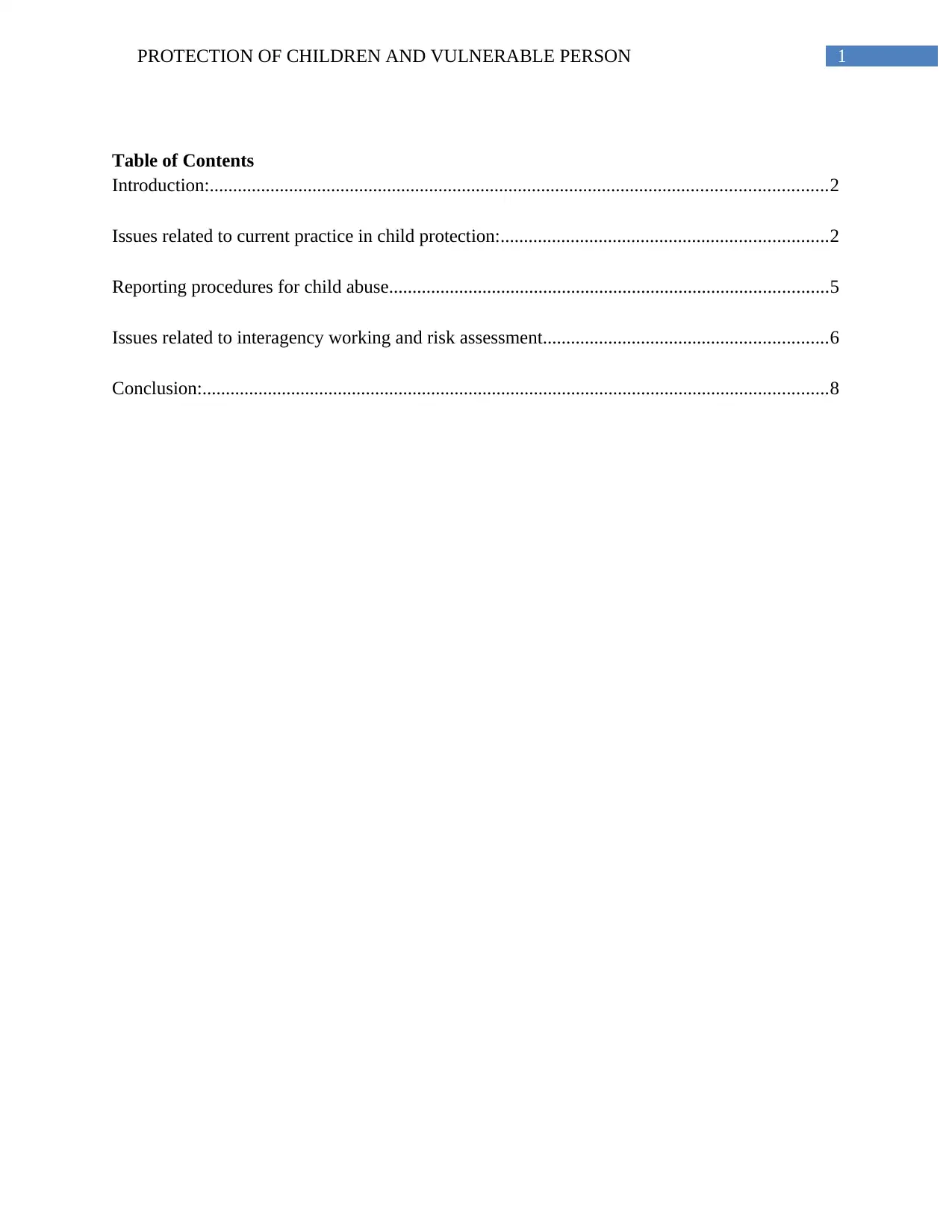
1PROTECTION OF CHILDREN AND VULNERABLE PERSON
Table of Contents
Introduction:....................................................................................................................................2
Issues related to current practice in child protection:......................................................................2
Reporting procedures for child abuse..............................................................................................5
Issues related to interagency working and risk assessment.............................................................6
Conclusion:......................................................................................................................................8
Table of Contents
Introduction:....................................................................................................................................2
Issues related to current practice in child protection:......................................................................2
Reporting procedures for child abuse..............................................................................................5
Issues related to interagency working and risk assessment.............................................................6
Conclusion:......................................................................................................................................8
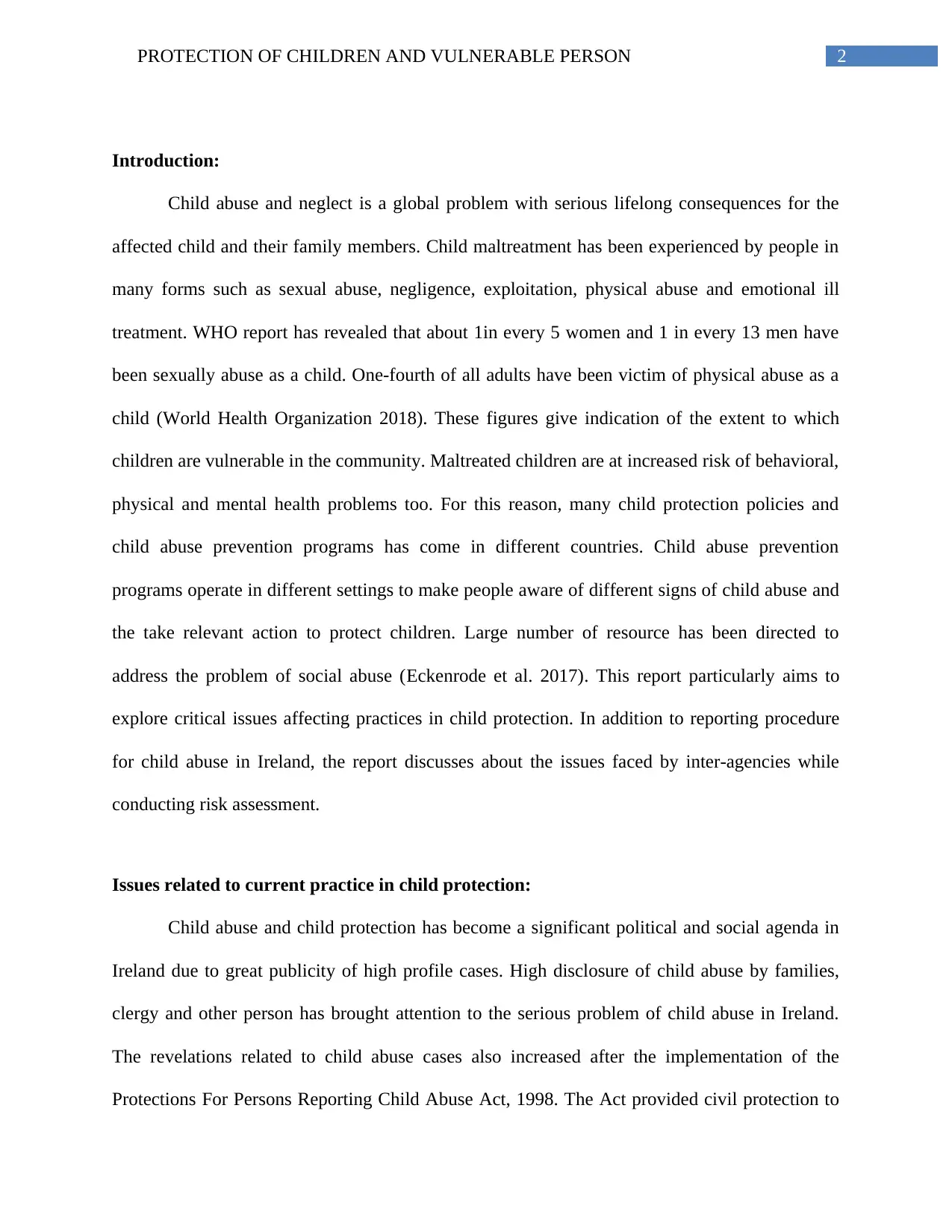
2PROTECTION OF CHILDREN AND VULNERABLE PERSON
Introduction:
Child abuse and neglect is a global problem with serious lifelong consequences for the
affected child and their family members. Child maltreatment has been experienced by people in
many forms such as sexual abuse, negligence, exploitation, physical abuse and emotional ill
treatment. WHO report has revealed that about 1in every 5 women and 1 in every 13 men have
been sexually abuse as a child. One-fourth of all adults have been victim of physical abuse as a
child (World Health Organization 2018). These figures give indication of the extent to which
children are vulnerable in the community. Maltreated children are at increased risk of behavioral,
physical and mental health problems too. For this reason, many child protection policies and
child abuse prevention programs has come in different countries. Child abuse prevention
programs operate in different settings to make people aware of different signs of child abuse and
the take relevant action to protect children. Large number of resource has been directed to
address the problem of social abuse (Eckenrode et al. 2017). This report particularly aims to
explore critical issues affecting practices in child protection. In addition to reporting procedure
for child abuse in Ireland, the report discusses about the issues faced by inter-agencies while
conducting risk assessment.
Issues related to current practice in child protection:
Child abuse and child protection has become a significant political and social agenda in
Ireland due to great publicity of high profile cases. High disclosure of child abuse by families,
clergy and other person has brought attention to the serious problem of child abuse in Ireland.
The revelations related to child abuse cases also increased after the implementation of the
Protections For Persons Reporting Child Abuse Act, 1998. The Act provided civil protection to
Introduction:
Child abuse and neglect is a global problem with serious lifelong consequences for the
affected child and their family members. Child maltreatment has been experienced by people in
many forms such as sexual abuse, negligence, exploitation, physical abuse and emotional ill
treatment. WHO report has revealed that about 1in every 5 women and 1 in every 13 men have
been sexually abuse as a child. One-fourth of all adults have been victim of physical abuse as a
child (World Health Organization 2018). These figures give indication of the extent to which
children are vulnerable in the community. Maltreated children are at increased risk of behavioral,
physical and mental health problems too. For this reason, many child protection policies and
child abuse prevention programs has come in different countries. Child abuse prevention
programs operate in different settings to make people aware of different signs of child abuse and
the take relevant action to protect children. Large number of resource has been directed to
address the problem of social abuse (Eckenrode et al. 2017). This report particularly aims to
explore critical issues affecting practices in child protection. In addition to reporting procedure
for child abuse in Ireland, the report discusses about the issues faced by inter-agencies while
conducting risk assessment.
Issues related to current practice in child protection:
Child abuse and child protection has become a significant political and social agenda in
Ireland due to great publicity of high profile cases. High disclosure of child abuse by families,
clergy and other person has brought attention to the serious problem of child abuse in Ireland.
The revelations related to child abuse cases also increased after the implementation of the
Protections For Persons Reporting Child Abuse Act, 1998. The Act provided civil protection to
⊘ This is a preview!⊘
Do you want full access?
Subscribe today to unlock all pages.

Trusted by 1+ million students worldwide
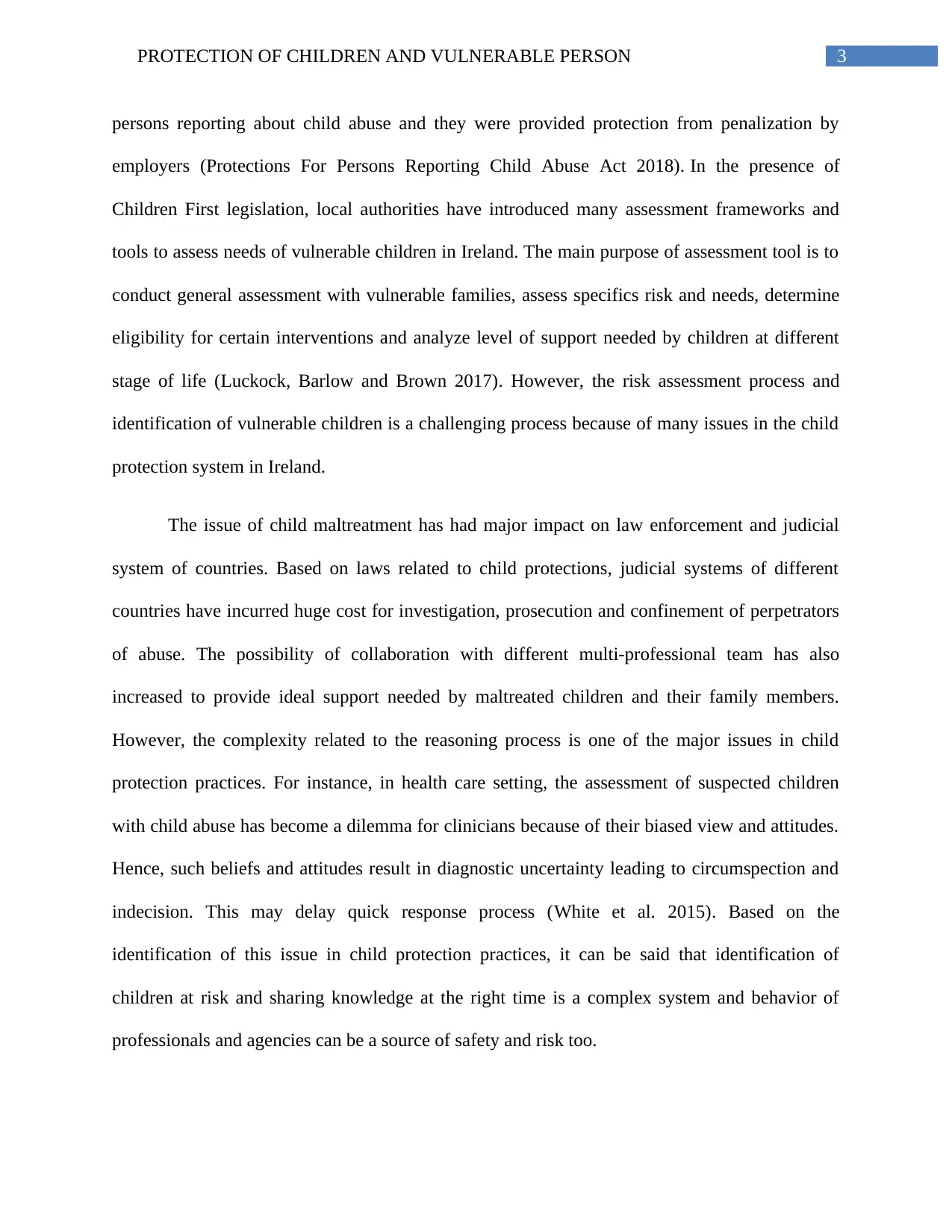
3PROTECTION OF CHILDREN AND VULNERABLE PERSON
persons reporting about child abuse and they were provided protection from penalization by
employers (Protections For Persons Reporting Child Abuse Act 2018). In the presence of
Children First legislation, local authorities have introduced many assessment frameworks and
tools to assess needs of vulnerable children in Ireland. The main purpose of assessment tool is to
conduct general assessment with vulnerable families, assess specifics risk and needs, determine
eligibility for certain interventions and analyze level of support needed by children at different
stage of life (Luckock, Barlow and Brown 2017). However, the risk assessment process and
identification of vulnerable children is a challenging process because of many issues in the child
protection system in Ireland.
The issue of child maltreatment has had major impact on law enforcement and judicial
system of countries. Based on laws related to child protections, judicial systems of different
countries have incurred huge cost for investigation, prosecution and confinement of perpetrators
of abuse. The possibility of collaboration with different multi-professional team has also
increased to provide ideal support needed by maltreated children and their family members.
However, the complexity related to the reasoning process is one of the major issues in child
protection practices. For instance, in health care setting, the assessment of suspected children
with child abuse has become a dilemma for clinicians because of their biased view and attitudes.
Hence, such beliefs and attitudes result in diagnostic uncertainty leading to circumspection and
indecision. This may delay quick response process (White et al. 2015). Based on the
identification of this issue in child protection practices, it can be said that identification of
children at risk and sharing knowledge at the right time is a complex system and behavior of
professionals and agencies can be a source of safety and risk too.
persons reporting about child abuse and they were provided protection from penalization by
employers (Protections For Persons Reporting Child Abuse Act 2018). In the presence of
Children First legislation, local authorities have introduced many assessment frameworks and
tools to assess needs of vulnerable children in Ireland. The main purpose of assessment tool is to
conduct general assessment with vulnerable families, assess specifics risk and needs, determine
eligibility for certain interventions and analyze level of support needed by children at different
stage of life (Luckock, Barlow and Brown 2017). However, the risk assessment process and
identification of vulnerable children is a challenging process because of many issues in the child
protection system in Ireland.
The issue of child maltreatment has had major impact on law enforcement and judicial
system of countries. Based on laws related to child protections, judicial systems of different
countries have incurred huge cost for investigation, prosecution and confinement of perpetrators
of abuse. The possibility of collaboration with different multi-professional team has also
increased to provide ideal support needed by maltreated children and their family members.
However, the complexity related to the reasoning process is one of the major issues in child
protection practices. For instance, in health care setting, the assessment of suspected children
with child abuse has become a dilemma for clinicians because of their biased view and attitudes.
Hence, such beliefs and attitudes result in diagnostic uncertainty leading to circumspection and
indecision. This may delay quick response process (White et al. 2015). Based on the
identification of this issue in child protection practices, it can be said that identification of
children at risk and sharing knowledge at the right time is a complex system and behavior of
professionals and agencies can be a source of safety and risk too.
Paraphrase This Document
Need a fresh take? Get an instant paraphrase of this document with our AI Paraphraser
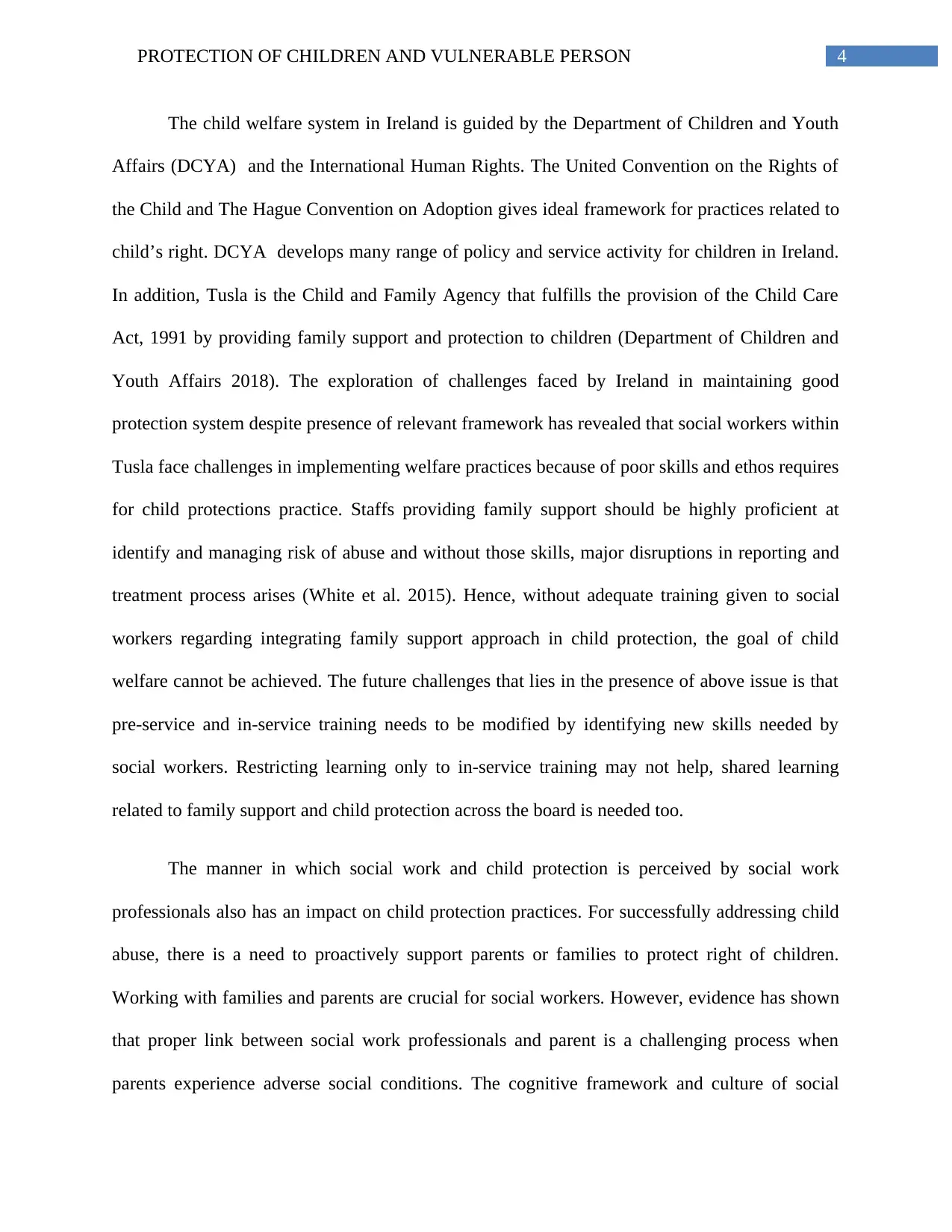
4PROTECTION OF CHILDREN AND VULNERABLE PERSON
The child welfare system in Ireland is guided by the Department of Children and Youth
Affairs (DCYA) and the International Human Rights. The United Convention on the Rights of
the Child and The Hague Convention on Adoption gives ideal framework for practices related to
child’s right. DCYA develops many range of policy and service activity for children in Ireland.
In addition, Tusla is the Child and Family Agency that fulfills the provision of the Child Care
Act, 1991 by providing family support and protection to children (Department of Children and
Youth Affairs 2018). The exploration of challenges faced by Ireland in maintaining good
protection system despite presence of relevant framework has revealed that social workers within
Tusla face challenges in implementing welfare practices because of poor skills and ethos requires
for child protections practice. Staffs providing family support should be highly proficient at
identify and managing risk of abuse and without those skills, major disruptions in reporting and
treatment process arises (White et al. 2015). Hence, without adequate training given to social
workers regarding integrating family support approach in child protection, the goal of child
welfare cannot be achieved. The future challenges that lies in the presence of above issue is that
pre-service and in-service training needs to be modified by identifying new skills needed by
social workers. Restricting learning only to in-service training may not help, shared learning
related to family support and child protection across the board is needed too.
The manner in which social work and child protection is perceived by social work
professionals also has an impact on child protection practices. For successfully addressing child
abuse, there is a need to proactively support parents or families to protect right of children.
Working with families and parents are crucial for social workers. However, evidence has shown
that proper link between social work professionals and parent is a challenging process when
parents experience adverse social conditions. The cognitive framework and culture of social
The child welfare system in Ireland is guided by the Department of Children and Youth
Affairs (DCYA) and the International Human Rights. The United Convention on the Rights of
the Child and The Hague Convention on Adoption gives ideal framework for practices related to
child’s right. DCYA develops many range of policy and service activity for children in Ireland.
In addition, Tusla is the Child and Family Agency that fulfills the provision of the Child Care
Act, 1991 by providing family support and protection to children (Department of Children and
Youth Affairs 2018). The exploration of challenges faced by Ireland in maintaining good
protection system despite presence of relevant framework has revealed that social workers within
Tusla face challenges in implementing welfare practices because of poor skills and ethos requires
for child protections practice. Staffs providing family support should be highly proficient at
identify and managing risk of abuse and without those skills, major disruptions in reporting and
treatment process arises (White et al. 2015). Hence, without adequate training given to social
workers regarding integrating family support approach in child protection, the goal of child
welfare cannot be achieved. The future challenges that lies in the presence of above issue is that
pre-service and in-service training needs to be modified by identifying new skills needed by
social workers. Restricting learning only to in-service training may not help, shared learning
related to family support and child protection across the board is needed too.
The manner in which social work and child protection is perceived by social work
professionals also has an impact on child protection practices. For successfully addressing child
abuse, there is a need to proactively support parents or families to protect right of children.
Working with families and parents are crucial for social workers. However, evidence has shown
that proper link between social work professionals and parent is a challenging process when
parents experience adverse social conditions. The cognitive framework and culture of social
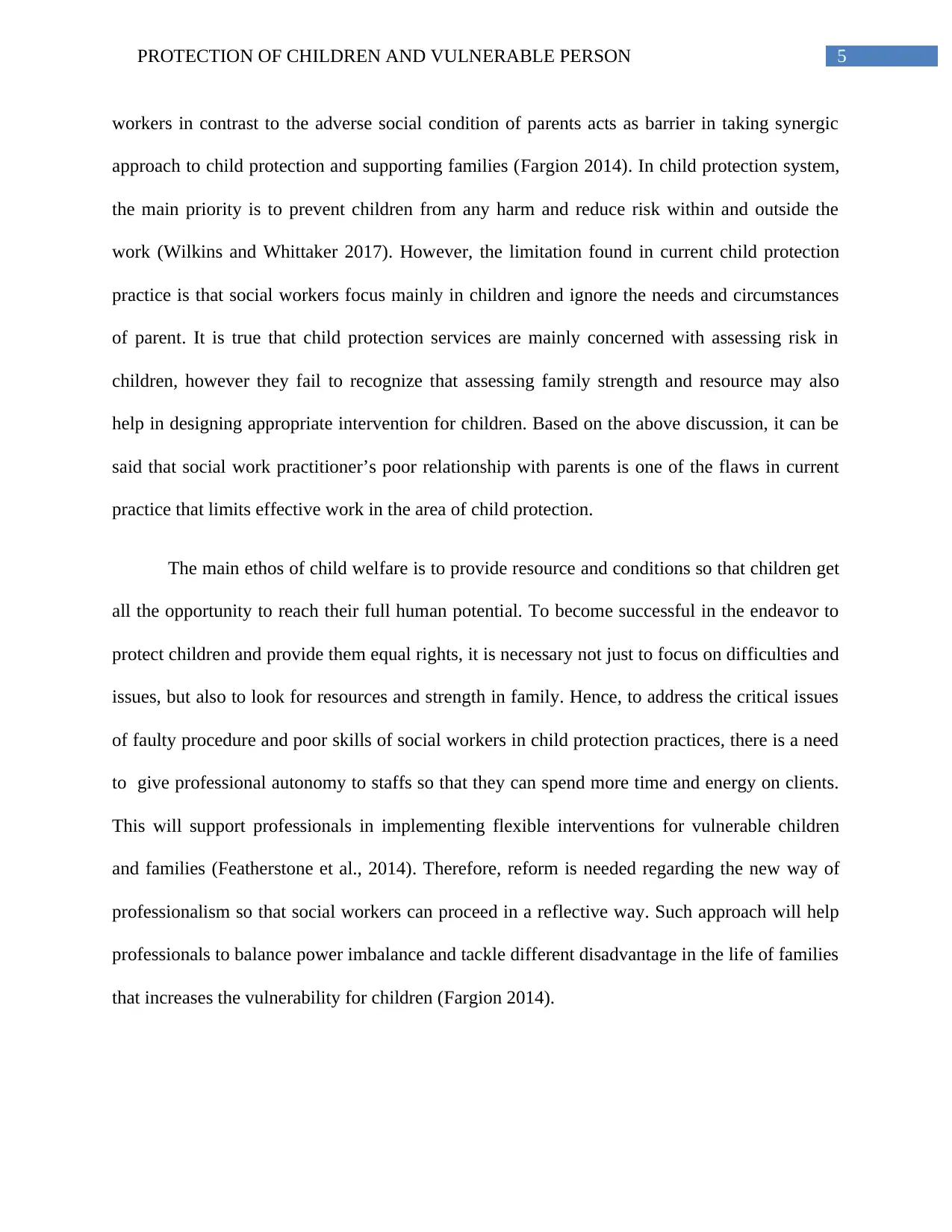
5PROTECTION OF CHILDREN AND VULNERABLE PERSON
workers in contrast to the adverse social condition of parents acts as barrier in taking synergic
approach to child protection and supporting families (Fargion 2014). In child protection system,
the main priority is to prevent children from any harm and reduce risk within and outside the
work (Wilkins and Whittaker 2017). However, the limitation found in current child protection
practice is that social workers focus mainly in children and ignore the needs and circumstances
of parent. It is true that child protection services are mainly concerned with assessing risk in
children, however they fail to recognize that assessing family strength and resource may also
help in designing appropriate intervention for children. Based on the above discussion, it can be
said that social work practitioner’s poor relationship with parents is one of the flaws in current
practice that limits effective work in the area of child protection.
The main ethos of child welfare is to provide resource and conditions so that children get
all the opportunity to reach their full human potential. To become successful in the endeavor to
protect children and provide them equal rights, it is necessary not just to focus on difficulties and
issues, but also to look for resources and strength in family. Hence, to address the critical issues
of faulty procedure and poor skills of social workers in child protection practices, there is a need
to give professional autonomy to staffs so that they can spend more time and energy on clients.
This will support professionals in implementing flexible interventions for vulnerable children
and families (Featherstone et al., 2014). Therefore, reform is needed regarding the new way of
professionalism so that social workers can proceed in a reflective way. Such approach will help
professionals to balance power imbalance and tackle different disadvantage in the life of families
that increases the vulnerability for children (Fargion 2014).
workers in contrast to the adverse social condition of parents acts as barrier in taking synergic
approach to child protection and supporting families (Fargion 2014). In child protection system,
the main priority is to prevent children from any harm and reduce risk within and outside the
work (Wilkins and Whittaker 2017). However, the limitation found in current child protection
practice is that social workers focus mainly in children and ignore the needs and circumstances
of parent. It is true that child protection services are mainly concerned with assessing risk in
children, however they fail to recognize that assessing family strength and resource may also
help in designing appropriate intervention for children. Based on the above discussion, it can be
said that social work practitioner’s poor relationship with parents is one of the flaws in current
practice that limits effective work in the area of child protection.
The main ethos of child welfare is to provide resource and conditions so that children get
all the opportunity to reach their full human potential. To become successful in the endeavor to
protect children and provide them equal rights, it is necessary not just to focus on difficulties and
issues, but also to look for resources and strength in family. Hence, to address the critical issues
of faulty procedure and poor skills of social workers in child protection practices, there is a need
to give professional autonomy to staffs so that they can spend more time and energy on clients.
This will support professionals in implementing flexible interventions for vulnerable children
and families (Featherstone et al., 2014). Therefore, reform is needed regarding the new way of
professionalism so that social workers can proceed in a reflective way. Such approach will help
professionals to balance power imbalance and tackle different disadvantage in the life of families
that increases the vulnerability for children (Fargion 2014).
⊘ This is a preview!⊘
Do you want full access?
Subscribe today to unlock all pages.

Trusted by 1+ million students worldwide

6PROTECTION OF CHILDREN AND VULNERABLE PERSON
Reporting procedures for child abuse
The Child abuse reporting procedure is mainly concerned with giving proper guidance to
people to help them identify whether child abuse has occurred or not and learn the way to make
complain of child abuse with local law enforcement. According to child abuse reporting
procedures, child abuse may occur in the form of physical injury or sexual exploitation. Physical
injury is related to injury to a child by another person for other reasons apart from accidental
means, whereas sexual abuse is related to negligent treatment endangering the health and
emotional stability of a child (Beker and Robin 2014). If any people in Ireland suspects that a
child has been abused or is at risk of abuse, then they have the duty to report about suspicion to
Tusla. The complaints can be raised either by phone or by writing. People who are concerned
about their safety can also report anonymously. Besides this, the law of Ireland also provided
protection to people reporting about abuse so that such incidents are not ignored and prompt
action can be taken for perpetrators of abuse. Apart from people in the community, different
organizations also have the responsibility to assign certain people to deal with suspected and
actual abuse (Department of Children and Youth Affairs 2018). This may help to keep children
safe in schools and other institution too.
Issues related to interagency working and risk assessment
As per the directives of the Government of Ireland and the National Children’s Strategy,
cooperation between interagency is vital to meet the goals and objectives of child protection. It
involves proper cooperation between government departments, NGOs and state agencies to
appropriately conduct risk assessment and initiate the process for child protection. Other inter-
agency arrangements that has emerged with time includes establishment of new organizations
locally and development of area based approach for child welfare and well-being. The review of
Reporting procedures for child abuse
The Child abuse reporting procedure is mainly concerned with giving proper guidance to
people to help them identify whether child abuse has occurred or not and learn the way to make
complain of child abuse with local law enforcement. According to child abuse reporting
procedures, child abuse may occur in the form of physical injury or sexual exploitation. Physical
injury is related to injury to a child by another person for other reasons apart from accidental
means, whereas sexual abuse is related to negligent treatment endangering the health and
emotional stability of a child (Beker and Robin 2014). If any people in Ireland suspects that a
child has been abused or is at risk of abuse, then they have the duty to report about suspicion to
Tusla. The complaints can be raised either by phone or by writing. People who are concerned
about their safety can also report anonymously. Besides this, the law of Ireland also provided
protection to people reporting about abuse so that such incidents are not ignored and prompt
action can be taken for perpetrators of abuse. Apart from people in the community, different
organizations also have the responsibility to assign certain people to deal with suspected and
actual abuse (Department of Children and Youth Affairs 2018). This may help to keep children
safe in schools and other institution too.
Issues related to interagency working and risk assessment
As per the directives of the Government of Ireland and the National Children’s Strategy,
cooperation between interagency is vital to meet the goals and objectives of child protection. It
involves proper cooperation between government departments, NGOs and state agencies to
appropriately conduct risk assessment and initiate the process for child protection. Other inter-
agency arrangements that has emerged with time includes establishment of new organizations
locally and development of area based approach for child welfare and well-being. The review of
Paraphrase This Document
Need a fresh take? Get an instant paraphrase of this document with our AI Paraphraser

7PROTECTION OF CHILDREN AND VULNERABLE PERSON
the performance of inter-agency arrangement has revealed several issues such as professional
difference and conflict between social workers and general practitioners, lack of shared
responsibility, inconsistent support and lack of formal linkage dye to power imbalance and lack
of mandates for cooperation in inter-agency works (Duggan, Corrigan and Social 2009). Such
kind of difference may hamper the purpose of inter-agency arrangement and create challenges in
risk assessment of clients too. Hence, to provide benefits to children and families, there is a need
to strengthen method that facilitates proper collaboration between inter-agencies.
The process of risk assessment in a child protection system related to the systematic
process of collecting information on conditions of family and observable threats to safety of a
child and determining the degree of risk for patient. Child welfare agencies use reliable risk
assessment tools to assess current and future harm to a child. However, the challenges in risk
assessment and treatment arise when cooperation between agencies does not exist and vital
information related to incidence of child abuse is not shared to interlinked agencies involved in
child protection. One research evidence has also revealed that instead of being involved in child
protection, many presence of issues in interagency work is itself leaving children in unsafe
situations (Coates 2017). As interagency collaboration is central to the protection of vulnerable
group, there is a need to identify barriers that limit collaboration and find strategies to promote
collaboration and increase the pace of response for maltreated children.
There might be several barriers to effective collaboration in interagency work. These
includes inefficiency of staffs in information sharing, conflict between principles underpinning
practice for clinicians and child protection worker, lack of clarity regarding processes and
expectation and inconsistent style of collaboration (Afzelius et al. 2018). In relations to the
identified issue in interagency work for child protection is Ireland, it is recommended to pay
the performance of inter-agency arrangement has revealed several issues such as professional
difference and conflict between social workers and general practitioners, lack of shared
responsibility, inconsistent support and lack of formal linkage dye to power imbalance and lack
of mandates for cooperation in inter-agency works (Duggan, Corrigan and Social 2009). Such
kind of difference may hamper the purpose of inter-agency arrangement and create challenges in
risk assessment of clients too. Hence, to provide benefits to children and families, there is a need
to strengthen method that facilitates proper collaboration between inter-agencies.
The process of risk assessment in a child protection system related to the systematic
process of collecting information on conditions of family and observable threats to safety of a
child and determining the degree of risk for patient. Child welfare agencies use reliable risk
assessment tools to assess current and future harm to a child. However, the challenges in risk
assessment and treatment arise when cooperation between agencies does not exist and vital
information related to incidence of child abuse is not shared to interlinked agencies involved in
child protection. One research evidence has also revealed that instead of being involved in child
protection, many presence of issues in interagency work is itself leaving children in unsafe
situations (Coates 2017). As interagency collaboration is central to the protection of vulnerable
group, there is a need to identify barriers that limit collaboration and find strategies to promote
collaboration and increase the pace of response for maltreated children.
There might be several barriers to effective collaboration in interagency work. These
includes inefficiency of staffs in information sharing, conflict between principles underpinning
practice for clinicians and child protection worker, lack of clarity regarding processes and
expectation and inconsistent style of collaboration (Afzelius et al. 2018). In relations to the
identified issue in interagency work for child protection is Ireland, it is recommended to pay
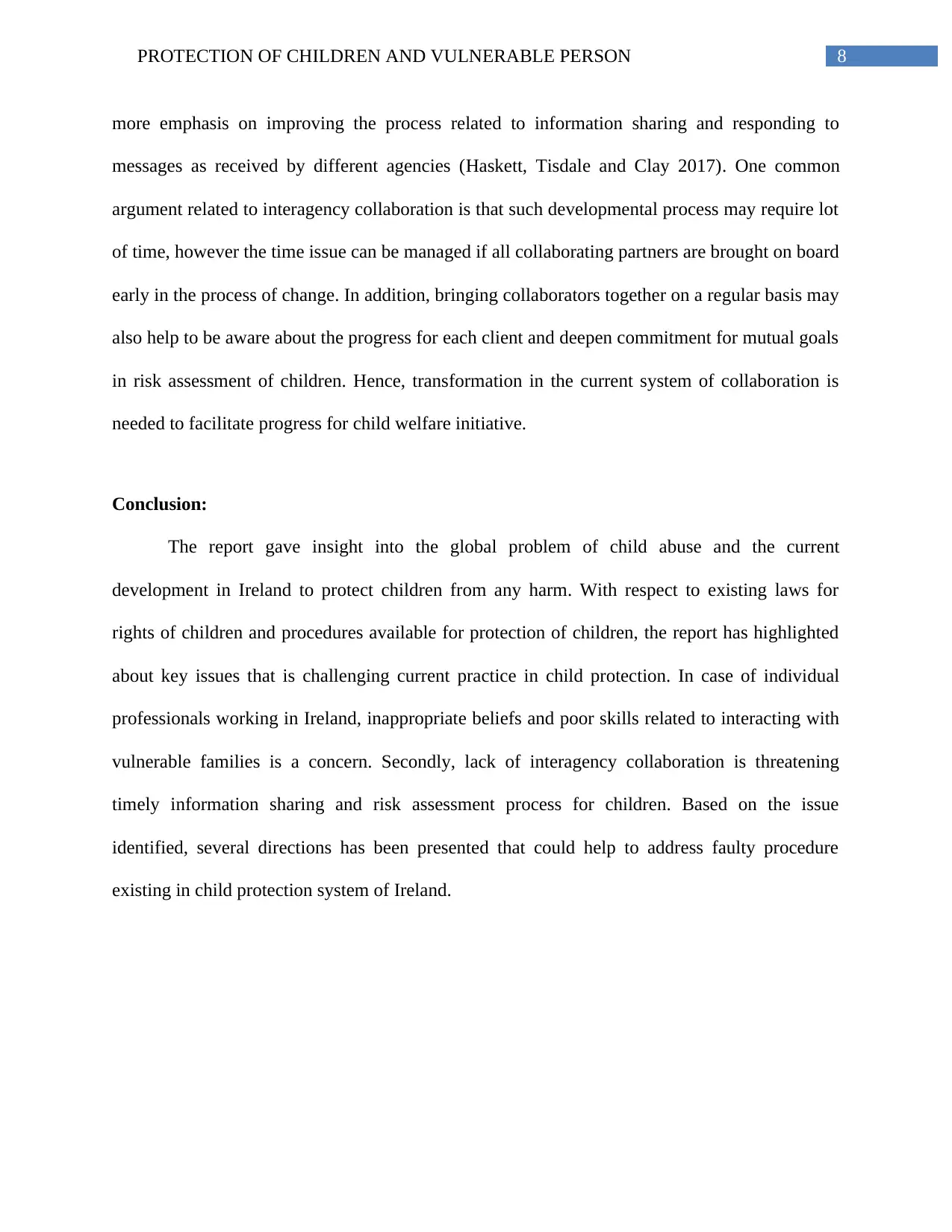
8PROTECTION OF CHILDREN AND VULNERABLE PERSON
more emphasis on improving the process related to information sharing and responding to
messages as received by different agencies (Haskett, Tisdale and Clay 2017). One common
argument related to interagency collaboration is that such developmental process may require lot
of time, however the time issue can be managed if all collaborating partners are brought on board
early in the process of change. In addition, bringing collaborators together on a regular basis may
also help to be aware about the progress for each client and deepen commitment for mutual goals
in risk assessment of children. Hence, transformation in the current system of collaboration is
needed to facilitate progress for child welfare initiative.
Conclusion:
The report gave insight into the global problem of child abuse and the current
development in Ireland to protect children from any harm. With respect to existing laws for
rights of children and procedures available for protection of children, the report has highlighted
about key issues that is challenging current practice in child protection. In case of individual
professionals working in Ireland, inappropriate beliefs and poor skills related to interacting with
vulnerable families is a concern. Secondly, lack of interagency collaboration is threatening
timely information sharing and risk assessment process for children. Based on the issue
identified, several directions has been presented that could help to address faulty procedure
existing in child protection system of Ireland.
more emphasis on improving the process related to information sharing and responding to
messages as received by different agencies (Haskett, Tisdale and Clay 2017). One common
argument related to interagency collaboration is that such developmental process may require lot
of time, however the time issue can be managed if all collaborating partners are brought on board
early in the process of change. In addition, bringing collaborators together on a regular basis may
also help to be aware about the progress for each client and deepen commitment for mutual goals
in risk assessment of children. Hence, transformation in the current system of collaboration is
needed to facilitate progress for child welfare initiative.
Conclusion:
The report gave insight into the global problem of child abuse and the current
development in Ireland to protect children from any harm. With respect to existing laws for
rights of children and procedures available for protection of children, the report has highlighted
about key issues that is challenging current practice in child protection. In case of individual
professionals working in Ireland, inappropriate beliefs and poor skills related to interacting with
vulnerable families is a concern. Secondly, lack of interagency collaboration is threatening
timely information sharing and risk assessment process for children. Based on the issue
identified, several directions has been presented that could help to address faulty procedure
existing in child protection system of Ireland.
⊘ This is a preview!⊘
Do you want full access?
Subscribe today to unlock all pages.

Trusted by 1+ million students worldwide

9PROTECTION OF CHILDREN AND VULNERABLE PERSON
Reference
Afzelius, M., Östman, M., Råstam, M. and Priebe, G., 2018. Parents in adult psychiatric care and
their children: a call for more interagency collaboration with social services and child and
adolescent psychiatry. Nordic journal of psychiatry, 72(1), pp.31-38.
Beker, J. and Robin, M., 2014. Assessing child maltreatment reports: The problem of false
allegations. Routledge.
Coates, D., 2017. Working with families with parental mental health and/or drug and alcohol
issues where there are child protection concerns: inter‐agency collaboration. Child & Family
Social Work, 22(S4), pp.1-10.
Department of Children and Youth Affairs 2018. Child Welfare and Protection - What We Do -
Department of Children and Youth Affairs - Ireland. Dcya.gov.ie. Retrieved 18 January 2018,
from https://www.dcya.gov.ie/viewdoc.asp?fn=/documents/Child_Welfare_Protection/intro.htm
Department of Children and Youth Affairs 2018. Children First: National Guidance for the
Protection and Welfare of Children Retrieved 18 January 2018, from
https://www.dcya.gov.ie/documents/Publications/ChildrenFirst.pdf
Devaney, C. and Gregor, C.M., 2017. Child protection and family support practice in Ireland: a
contribution to present debates from a historical perspective. Child & Family Social Work, 22(3),
pp.1255-1263.
Duggan, C., Corrigan, C. and Social, W.R.C., 2009. A literature review of inter-agency work
with a particular focus on children's services. Children Acts Advisory Board.
Reference
Afzelius, M., Östman, M., Råstam, M. and Priebe, G., 2018. Parents in adult psychiatric care and
their children: a call for more interagency collaboration with social services and child and
adolescent psychiatry. Nordic journal of psychiatry, 72(1), pp.31-38.
Beker, J. and Robin, M., 2014. Assessing child maltreatment reports: The problem of false
allegations. Routledge.
Coates, D., 2017. Working with families with parental mental health and/or drug and alcohol
issues where there are child protection concerns: inter‐agency collaboration. Child & Family
Social Work, 22(S4), pp.1-10.
Department of Children and Youth Affairs 2018. Child Welfare and Protection - What We Do -
Department of Children and Youth Affairs - Ireland. Dcya.gov.ie. Retrieved 18 January 2018,
from https://www.dcya.gov.ie/viewdoc.asp?fn=/documents/Child_Welfare_Protection/intro.htm
Department of Children and Youth Affairs 2018. Children First: National Guidance for the
Protection and Welfare of Children Retrieved 18 January 2018, from
https://www.dcya.gov.ie/documents/Publications/ChildrenFirst.pdf
Devaney, C. and Gregor, C.M., 2017. Child protection and family support practice in Ireland: a
contribution to present debates from a historical perspective. Child & Family Social Work, 22(3),
pp.1255-1263.
Duggan, C., Corrigan, C. and Social, W.R.C., 2009. A literature review of inter-agency work
with a particular focus on children's services. Children Acts Advisory Board.
Paraphrase This Document
Need a fresh take? Get an instant paraphrase of this document with our AI Paraphraser
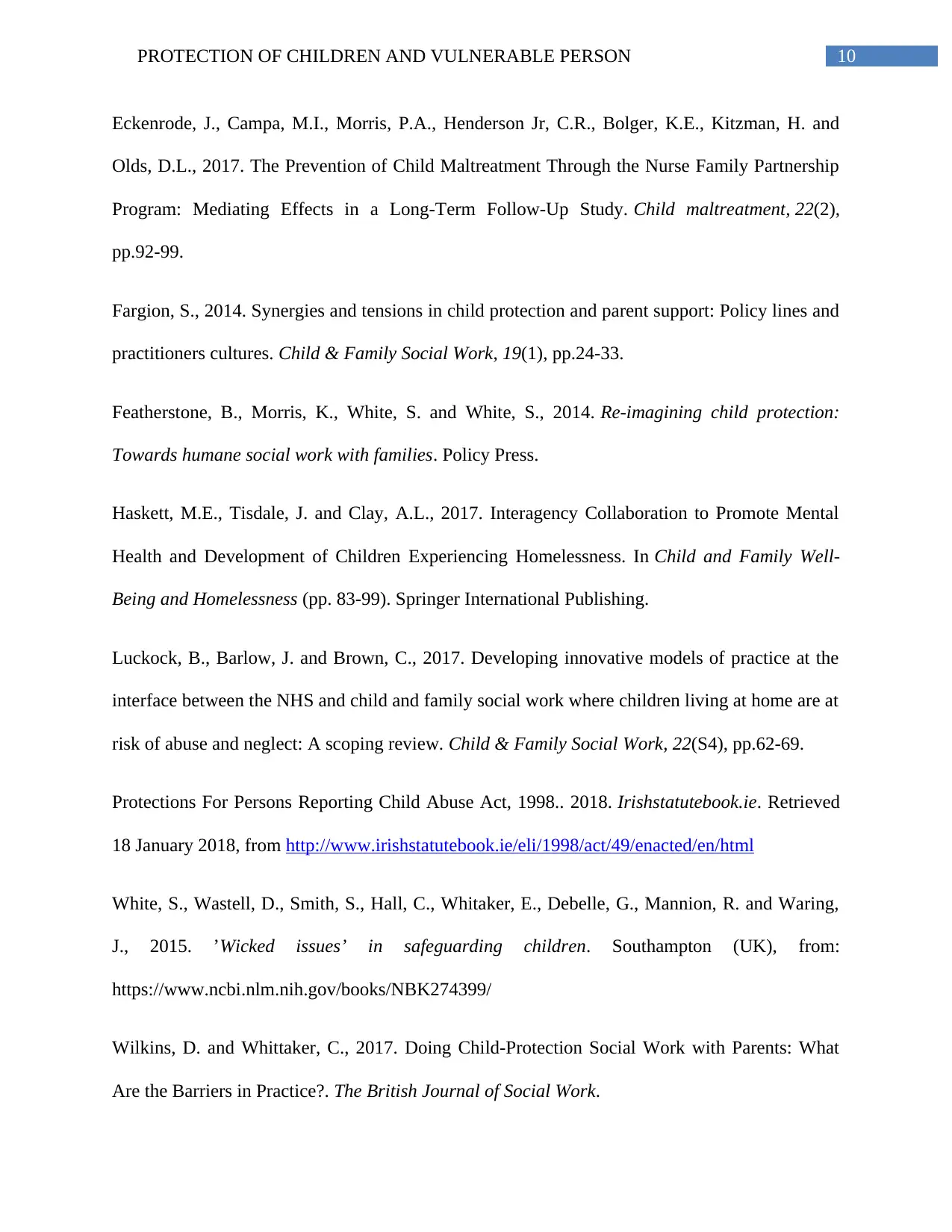
10PROTECTION OF CHILDREN AND VULNERABLE PERSON
Eckenrode, J., Campa, M.I., Morris, P.A., Henderson Jr, C.R., Bolger, K.E., Kitzman, H. and
Olds, D.L., 2017. The Prevention of Child Maltreatment Through the Nurse Family Partnership
Program: Mediating Effects in a Long-Term Follow-Up Study. Child maltreatment, 22(2),
pp.92-99.
Fargion, S., 2014. Synergies and tensions in child protection and parent support: Policy lines and
practitioners cultures. Child & Family Social Work, 19(1), pp.24-33.
Featherstone, B., Morris, K., White, S. and White, S., 2014. Re-imagining child protection:
Towards humane social work with families. Policy Press.
Haskett, M.E., Tisdale, J. and Clay, A.L., 2017. Interagency Collaboration to Promote Mental
Health and Development of Children Experiencing Homelessness. In Child and Family Well-
Being and Homelessness (pp. 83-99). Springer International Publishing.
Luckock, B., Barlow, J. and Brown, C., 2017. Developing innovative models of practice at the
interface between the NHS and child and family social work where children living at home are at
risk of abuse and neglect: A scoping review. Child & Family Social Work, 22(S4), pp.62-69.
Protections For Persons Reporting Child Abuse Act, 1998.. 2018. Irishstatutebook.ie. Retrieved
18 January 2018, from http://www.irishstatutebook.ie/eli/1998/act/49/enacted/en/html
White, S., Wastell, D., Smith, S., Hall, C., Whitaker, E., Debelle, G., Mannion, R. and Waring,
J., 2015. ’Wicked issues’ in safeguarding children. Southampton (UK), from:
https://www.ncbi.nlm.nih.gov/books/NBK274399/
Wilkins, D. and Whittaker, C., 2017. Doing Child-Protection Social Work with Parents: What
Are the Barriers in Practice?. The British Journal of Social Work.
Eckenrode, J., Campa, M.I., Morris, P.A., Henderson Jr, C.R., Bolger, K.E., Kitzman, H. and
Olds, D.L., 2017. The Prevention of Child Maltreatment Through the Nurse Family Partnership
Program: Mediating Effects in a Long-Term Follow-Up Study. Child maltreatment, 22(2),
pp.92-99.
Fargion, S., 2014. Synergies and tensions in child protection and parent support: Policy lines and
practitioners cultures. Child & Family Social Work, 19(1), pp.24-33.
Featherstone, B., Morris, K., White, S. and White, S., 2014. Re-imagining child protection:
Towards humane social work with families. Policy Press.
Haskett, M.E., Tisdale, J. and Clay, A.L., 2017. Interagency Collaboration to Promote Mental
Health and Development of Children Experiencing Homelessness. In Child and Family Well-
Being and Homelessness (pp. 83-99). Springer International Publishing.
Luckock, B., Barlow, J. and Brown, C., 2017. Developing innovative models of practice at the
interface between the NHS and child and family social work where children living at home are at
risk of abuse and neglect: A scoping review. Child & Family Social Work, 22(S4), pp.62-69.
Protections For Persons Reporting Child Abuse Act, 1998.. 2018. Irishstatutebook.ie. Retrieved
18 January 2018, from http://www.irishstatutebook.ie/eli/1998/act/49/enacted/en/html
White, S., Wastell, D., Smith, S., Hall, C., Whitaker, E., Debelle, G., Mannion, R. and Waring,
J., 2015. ’Wicked issues’ in safeguarding children. Southampton (UK), from:
https://www.ncbi.nlm.nih.gov/books/NBK274399/
Wilkins, D. and Whittaker, C., 2017. Doing Child-Protection Social Work with Parents: What
Are the Barriers in Practice?. The British Journal of Social Work.
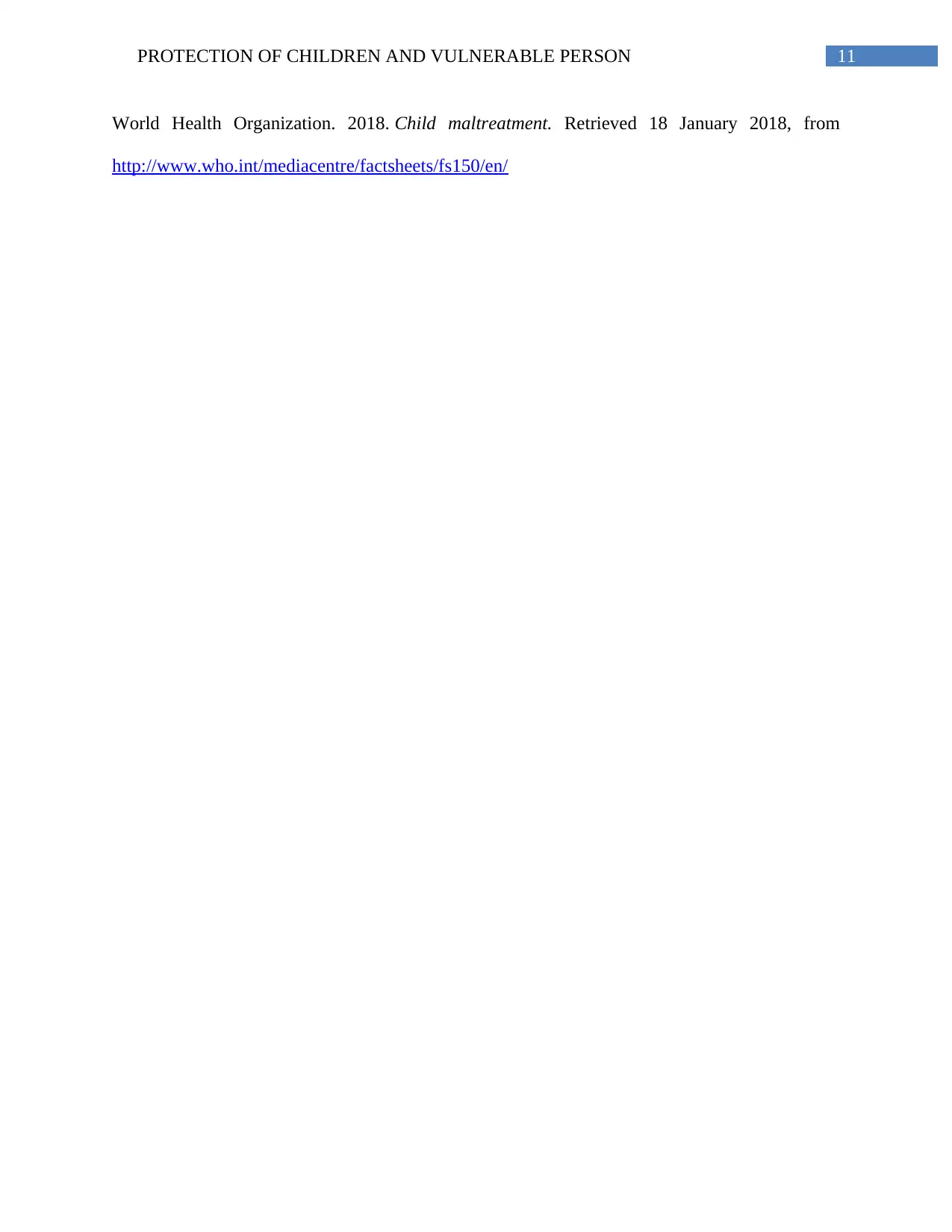
11PROTECTION OF CHILDREN AND VULNERABLE PERSON
World Health Organization. 2018. Child maltreatment. Retrieved 18 January 2018, from
http://www.who.int/mediacentre/factsheets/fs150/en/
World Health Organization. 2018. Child maltreatment. Retrieved 18 January 2018, from
http://www.who.int/mediacentre/factsheets/fs150/en/
⊘ This is a preview!⊘
Do you want full access?
Subscribe today to unlock all pages.

Trusted by 1+ million students worldwide
1 out of 12
Related Documents
Your All-in-One AI-Powered Toolkit for Academic Success.
+13062052269
info@desklib.com
Available 24*7 on WhatsApp / Email
![[object Object]](/_next/static/media/star-bottom.7253800d.svg)
Unlock your academic potential
Copyright © 2020–2025 A2Z Services. All Rights Reserved. Developed and managed by ZUCOL.




